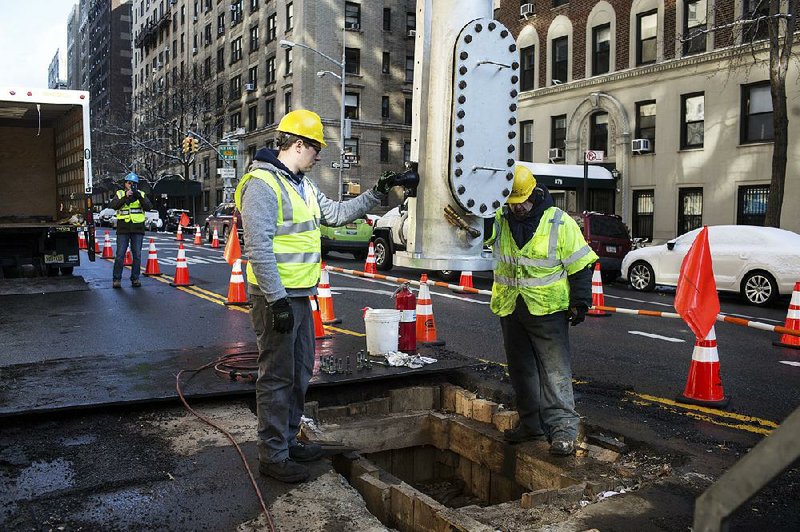A robot has been creeping through a gas main in New York City.
Its mission is to repair potentially leaky joints in an aging component of New York City's increasingly creaky infrastructure, no small concern when natural gas is involved. It can do the job without shutting off the gas to buildings supplied by the mains, no small concern to the people in the buildings.
If Consolidated Edison did the same repairs the old-fashioned way, using crews in hard hats and with jackhammers, the utility would first have to shut the gas off up and down the line and purge the main. It would bring in tanks of natural gas to supply buildings fed by the main. And, finally, it would either remove and replace the old main, or drill into it every 12 feet, doctoring every joint along the way.
"Disruptive," said Robert Kodadek, the chief technology officer of ULC Robotics, the Long Island, N.Y., company that developed the robot that has been crawling under West End Avenue on the Upper West Side of Manhattan. "We don't need to shut the gas off or block the roadway, close businesses or take people's homes off the gas for us to rehabilitate the pipeline."
He and Consolidated Edison officials say that even though the gas remains flowing, there is no danger of fire or explosion because oxygen would be necessary for a spark, and the gas mains are oxygen-free. The robot enters and exits the main through a "launch tube" from which oxygen is expelled before the robot slides into the main. The robot, controlled by a technician in a trailer on the street, goes into the gas main at the start of the workday and comes out at quitting time.
The robot has proved so reliable that it has found work in other parts of the United States and in other countries. It goes by the matter-of-fact name CISBOT, for cast-iron sealing robot. As the acronym suggests, the gas mains the robot travels through are made of cast iron.
Kodadek did some calculations. On the stretch of West End Avenue between West 102nd and West 103rd streets where the robot was working on a recent sunny morning, he said, there were about 109 joints in the gas main beneath the pavement.
So, he said, 109 holes did not have to be drilled.
The robot is also less expensive than the old methods of maintaining the mains. John Ciallella, Consolidated Edison's section manager for gas engineering reliability, said that hiring ULC Robotics for the work with the robot on West End Avenue cost $400,000. To do the job the way such work used to be done would have cost $1.5 million to $1.8 million, he said.
Baby boomers old enough to remember Erector Sets might think the cast-iron sealing robot was constructed from the parts bins of their childhoods. It is long, heavy on the metal, not terribly stylish and somewhat short on personality.
Other such robots have wriggled through utility pipes in Brooklyn, in Massachusetts and in Britain and Ireland. Along the way, they have made intriguing discoveries in gas mains where nothing but cast iron should have shown up, since the gas is invisible.
Kodadek remembered the day a robot focused on stilettos in a gas main in Brooklyn. He said he had considered sending a photograph to the Costume Institute at the Metropolitan Museum of Art for help in identifying them but never got around to doing so.
On another run, a robot found a baseball. Who had swatted at it was a mystery -- it was not autographed. How it got there was a mystery, too.
And on a crawl under Berkeley Street in Boston, a robot sent back images of a newspaper with an article about the 1939 World's Fair in New York.
Like a tricycle, the robot has three wheels, but it travels on only two. The third wheel is on top and pops up once the robot is inside the gas main. It is on an arm that reaches out until the wheel touches the ceiling of the main. Or the bottom of the main, if the robot is rotated so that the other two wheels are on the top. The robot can swirl 360 degrees in a few seconds.
"It helps to reduce traffic disruptions, potentially to save lives and at the time it was unique," said Eugene Demaitre, senior editor of Robotics Business Review, an industry magazine that awarded the cast-iron sealing robot a "game changer" award in 2015. "And it's doing it in a way that's safer than sending a human into the pipe or draining the whole main and drilling into the street. And it's able to operate under difficult conditions. You're in a live main, there's gas and yet still they're helping our increasingly complex infrastructure continue to function."
The CISBOT device has LEDs to illuminate its path and sensors that can detect whether gas is leaking from each joint it rolls past. It also has a drill head and an injection device to shoot sealant into holes in the joint that it has drilled.
The sealant fills the gaps between the strands of ropelike jute fiber, the material that was used to pack the joint for maximum snugness -- an effective seal years ago.
The jute did its job, keeping gas from escaping, but in the 1950s, Consolidated Edison switched from "town gas" made from coal to natural gas. The natural gas dried out the jute, and leaks became an occasional but potentially deadly problem that urban dwellers learned to live with. Consolidated Edison's Ciallella said the utility wanted the new sealant applied to each joint, even if there was no indication of a gas leak, to reduce the risk of future problems.
SundayMonday Business on 12/31/2017
